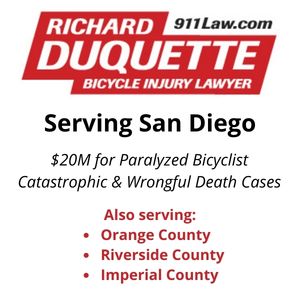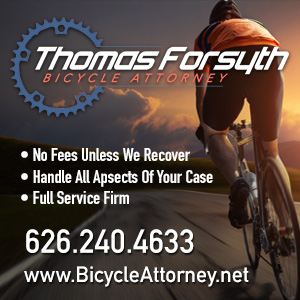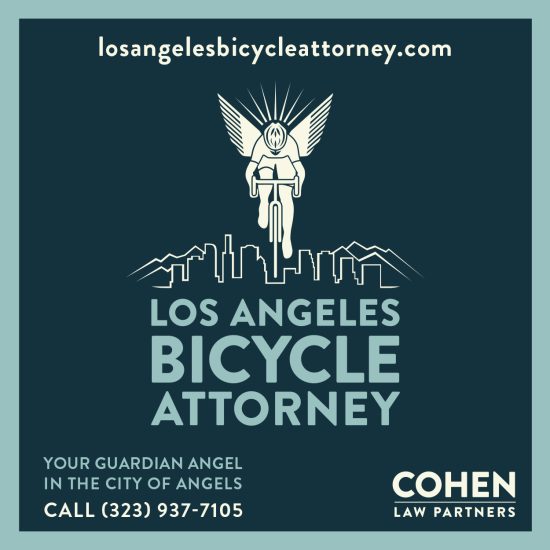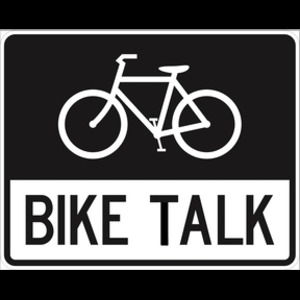The other day I was riding along one of my favorite routes through the Westside — a quiet, two lane street wide enough that cars can pass, while keeping me comfortably out of the dooring zone.
I came up behind an SUV that was stopped in the traffic lane, waiting to make a left turn onto a side street. A large pickup was stopped behind it; its wheels angled to go around the SUV on the right.
However, the driver appeared to be waiting for me to clear the area first. So I caught his eye in the mirror, nodded my thanks, and was about to ride through the gap when a car came speeding up on my left, blaring his horn for the other vehicles to get the hell out of his way.
Noticing the space I was about to move into, he cut sharply right to go around the other vehicles, forcing me to jam on my brakes. That meant he had to drive in the parking lane, though, and there was no way to complete his move without hitting the park car ahead of him.
So he was stuck right there, next to the pickup. And so was anyone else, since he’d boxed in the pickup in and was blocking my path, as well.
We all had no choice but to sit there until the SUV driver finally found an opening she was comfortable with, and made her left.
The gesture I made left little doubt what I thought of his driving skills. Yet his response surprised me. He merely pointed towards the other two cars, as if that explained everything — suggesting that they were responsible for what he had done, simply because the other drivers were in his way.
Once my path was clear, I rode off, wondering where that sense of entitlement comes from.
It’s not like he’s the only one. I see the same sort of thing just about any time I hit the streets, whether I’m on foot, on my bike or behind the wheel.
A car slows to make a right turn, and the driver behind will honk simply because he has to slow down. A stop light changes to red, and a trailing car zips around the cars ahead to go through the light anyway.
I’ve even seen a driver honk at a little old lady using a walker to cross the street, because she didn’t move fast enough for his satisfaction.
Then there was the truck driver who came to a sudden stop in the traffic lane ahead of me. And when I gestured to ask what was going on, he held out his cell and yelled, “I’m on the phone, a**hole!”
Oh, well that explains it then.
I used to think this was just an L.A. phenomenon. Or maybe the result of so many New York transplants bringing their famous impatience out west with them.
But as I’ve travelled around the country, I’ve seem similar behavior almost everywhere, even on the relatively bucolic streets of my old home town.
Of course, it’s not just drivers.
It’s the same attitude shown by pedestrians who step out in front of oncoming traffic in the middle of a block, expecting drivers to stop for them — even though they’re only a few feet from the next corner or crosswalk.
And the one shown by cyclists who blow through one red light after another, despite the presence of traffic, or who weave through traffic regardless of right-of-way. Even though the law, safety, common courtesy and common sense would seem to dictate otherwise.
I’ve tried to understand. Honestly, I have.
But I just can’t grasp the concept that one person’s convenience outweighs their own safety, as well as that of everyone around them. And it seems to be counterproductive, because it slows the overall flow of traffic as other road users are forced to respond.
So the net effect is that everyone deals with more congestion, more frustration. And more anger.
Maybe you can explain it.
Because I just don’t get it.
………..
The LACBC urges cyclists to urge the governor to sign the bicycle crosswalk and CA bike route bills. A writer for the Washington Post survives a week of biking in L.A. If you’re looking for somewhere to ride, Travelin’ Local offers a list of free days at L.A. museums. An Arizona newspaper applauds a police crackdown on cyclists who ignore traffic rules; evidently, drivers there never break the law. Why do so many drivers assume we think we’re invulnerable, when most cyclists have a keen sense of our vulnerability? The D.C. ghost bikes are gone once again. Yehuda Moon nails news coverage of cycling accidents. Biker Chicks crack down on two-abreast group riders. Town Mouse suggests that more bike lanes could keep us from having to become ninja cyclists. Finally, not bike related, but one the greatest Americans passed away in L.A. last week.





